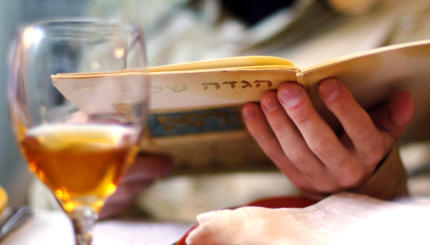The one thing I’m never last-minute about is having a haggadah. With countless different versions available — last year, when I was researching an article, the most current number I could find was over 4,000 — and so, when I think about our 30-person seder where everyone has a different haggadah, it seems so very unremarkable.
All of this is just a way of saying: do we really need another Passover haggadah?
 If the standard they’re being held to is Rabbi Eliyahu Klein’s A Mystical Haggadah, the answer is a resounding yes. I was really prepared to be disappointed. It promised a combination of cheese-laced personal polemics and watered-down Hasidic mysticism.
If the standard they’re being held to is Rabbi Eliyahu Klein’s A Mystical Haggadah, the answer is a resounding yes. I was really prepared to be disappointed. It promised a combination of cheese-laced personal polemics and watered-down Hasidic mysticism.
Klein, in his introduction, tells a number of personal stories. They start out as tame stories of his childhood in Detroit, but get sidetracked to that Galician region of Poland, and his experiences dabbling in Hasidic culture in Boro Park. In the middle of one of his recollections, there is the most extreme and beatific description of the Bobover Hasidim, who finish their seders by 11 P.M. in order to converge at the seder table of the Bobover Rebbe:
It would be an understatement to say that at least a thousand men, women, and children would surround the rebbeh; all the womenfolk (the wives, daughters, and granddaughters of the rebbeh’s family) would be allowed to sit at the rebbeh’s table surrounded by all his male Hasidim. All the women, dressed mostly in white and light, colorful clothes, would sit close to the rebbeh, and many women who couldn’t get in would be standing, throwing back the partition curtains in the back of the synagogue….The Passover Seder would proceed slowly and majestically. The “Galiziyaner” Hasidim (Hasidim from western Poland) would sing at least thirty or forty melodies throughout the night until the moment before dawn when the last words of the Haggadah would be recited.
This book, like the best haggadahs, mixes explanation, insights, and texts about the haggadah with the words of the haggadah itself and the steps of the seder. Ideally, I think, a seder is a combination of a bunch of people who have tons of stuff to contribute and who share about a tenth of it. The rest of the time, you can save for next year, or you can keep to yourself–so there’s enough time to listen to everyone else and their insights.
The ideal haggadah should do the same thing. There should be enough material to keep you riveted at every moment, enough to be compelling reading for even when you’re not in the middle of a seder, but it should also be able to fold into the background and simply let the ageless text itself flow. Little insights like this (from Rabbi Shlomo Carlebach, on breaking the middle matzah for the afikoman) do that job admirably:
“We break this matzah and hide a part of our selves. Only we know which part we are hiding. It is the part that is our broken heart that we hide and protect as we travel through the Haggadah. At the end of the seder, we bring out this precious part that has become healed. At this moment we eat this broken piece.” This means we integrate the healing of liberation into our daily lives.
“Haggadah” is the Hebrew word meaning “to tell,” and in every generation, we’re commanded to tell the story of the exodus from Egypt as though it happened to us personally. That means that there are as many versions of the haggadah as there are people who tell it–or, in any case, there should be. I guess 4,000 is a good start.
Haggadah
Pronounced: huh-GAH-duh or hah-gah-DAH, Origin: Hebrew, literally “telling” or “recounting.” A Haggadah is a book that is used to tell the story of the Exodus at the Passover seder. There are many versions available ranging from very traditional to nontraditional, and you can also make your own.
Hasidic
Pronounced: khah-SID-ik, Origin: Hebrew, a stream within ultra-Orthodox Judaism that grew out of an 18th-century mystical revival movement.
seder
Pronounced: SAY-der, Origin: Hebrew, literally “order”; usually used to describe the ceremonial meal and telling of the Passover story on the first two nights of Passover. (In Israel, Jews have a seder only on the first night of Passover.)


